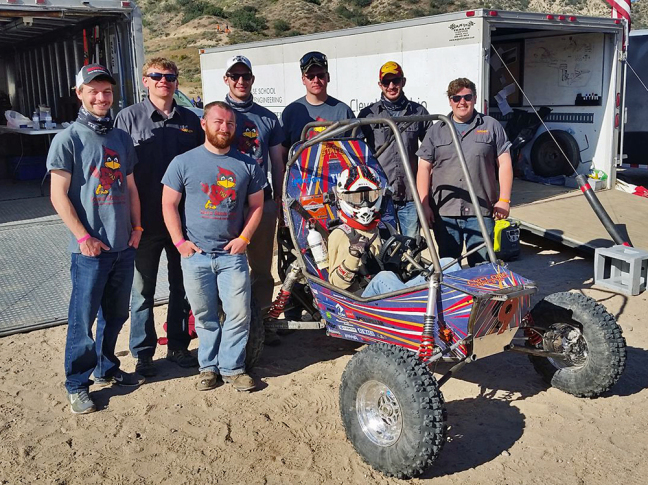
Iowa State's Baja SAE team competes in California in late April. Team members pictured are, left to right, Sam Vande Loo, Johnny Bavlsik, Andrew Raudabaugh, Jason Whited, Ryan Werner, Jordan Flick, Derick Whited, and Jameson Gavac. Larger photo. Photo courtesy of the Iowa State Baja SAE team.
6-13-17 update:
There were more broken suspension pieces (some caused by a rollover) for Cyclone Racing at the season’s third and final Baja SAE competition in Peoria, Illinois. Those failures limited the team and its mini off-road racer to four laps in the event’s four-hour endurance race. But the team had strong, top-15 finishes (of 106 registered teams) in four short events – the hill climb, acceleration, maneuverability and the rock crawl. But that’s not the race report Derick Whited, the team’s technical director, wanted to give. He wanted to talk about the students from Abu Dhabi whose car was held up in customs, putting them way behind and in a scramble to finish their car and pass technical inspection. Students from Iowa State and the University of Nebraska-Lincoln jumped in to help. It was a major challenge to try to rebuild the Abu Dhabi car in just three hours. Ultimately, the car never passed inspection. “Regardless, we showed what values we hold here in the Midwest to a team and others that have never been in the country before,” Whited said. “Overall, I think it was a great way to show that everyone is welcome in this community, and that teamwork can overcome distance and language barriers, even for really technical situations like this one.”
AMES, Iowa – It was detail-time in Cyclone Racing’s campus garage earlier this week.
The student-engineers of Iowa State’s Baja SAE team were checking and rechecking every part and piece, every nut and bolt of their mini off-road racer in preparation for the final race of the season, said Derick Whited, a senior from Dallas Center majoring in mechanical engineering and the team’s technical director.
The first two outings in the three-race series sponsored by SAE International, formerly known as the Society of Automotive Engineers, featured highs and lows:
At the late April season opener in in Gorman, California, the team had strong showings on and off the track: The team tied for 8th of 91 registered teams in engineering design. The students also finished 16th in hill climb and 18th in acceleration. The four-hour endurance race, however, featured broken suspension pieces, a faulty brake light and only nine completed laps. (The event winners completed 36 laps.) Overall, Cyclone Racing left California in 31st place.
Then in late May, the team traveled to Pittsburg, Kansas, with bigger suspension rods, steel parts replacing some aluminum parts, brake leaks fixed and some higher hopes. The students finished 16th in suspension performance and 18th in acceleration. But the endurance race proved challenging once again after another car crashed into the back of the Iowa State car, taking it out of the race on the first lap. Overall, the team finished 59th of 107 registered teams.
So what about this week’s competition in Peoria, Illinois?
Well, Whited said, all the crash damage is fixed. The rear suspension geometry has been adjusted so there’s more give over rough ground. And the brake pressure looks good.
“But I’m a little more cautious this time,” Whited said. “I had a little more hope for Kansas.”
And so he said the team will ease into the season’s final race, concentrating on learning as much as racing.
“I’d rather record some laps than fight for absolute first place,” he said.
This is a young team, he said. Last year’s team was full of veterans and had three top-10 overall finishes to show for it.
“When your team is young, it’s a learning process,” Whited said. “We’re learning what it takes to put together a good car.”
But there’s hope. He said the team has been able to hit 37 mph with the small, 10-horsepower engine mandated by competition rules.
“Over off-road terrain,” he said, “that’s pretty fast.”
